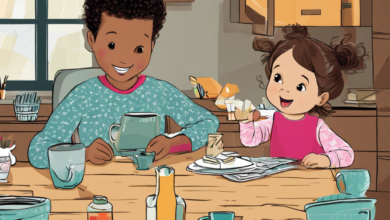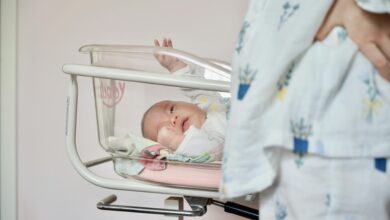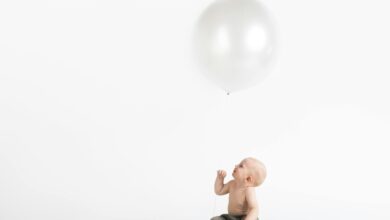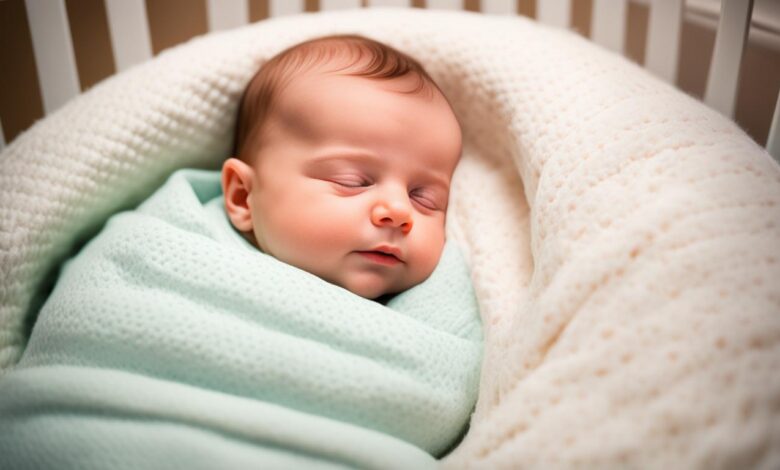
As parents, we always look for ways to keep our babies safe and cozy at night. But, it’s tricky to know when a blanket is safe for our little ones. So, the big question is: When can babies safely snuggle up with a blanket? This guide will help you understand what’s safe and what’s not when it comes to your baby’s sleep.
We’ll cover the basics of keeping your baby safe while sleeping. You’ll learn how to make sure your baby’s sleep area is safe from harm. We’ll also talk about how to pick the right bedding to prevent Sudden Infant Death Syndrome (SIDS).
Key Takeaways
- Understand the risks of loose bedding, including suffocation and strangulation hazards.
- Learn the latest SIDS prevention guidelines for creating a safe sleep environment.
- Discover the benefits of breathable crib mattresses and fitted sheets.
- Explore the pros and cons of sleep sacks versus blankets for your baby.
- Gain expert tips on transitioning to blanket use and following age-appropriate sleep recommendations.
Understanding the Risks of Loose Bedding
We all want our babies to sleep safely and soundly. But, loose bedding like blankets can be dangerous for them. It can lead to suffocation, strangulation, and increase the risk of Sudden Infant Death Syndrome (SIDS). It’s important to know the dangers and follow the latest guidelines for a safe sleep environment.
Suffocation and Strangulation Hazards
Loose bedding can cover an infant’s face, causing suffocation. It can also wrap around their neck, which is a strangulation risk. These dangers are especially high for babies under 12 months old. They may not be strong enough to get out of these dangerous situations.
SIDS and Sleep Environment Guidelines
Sudden Infant Death Syndrome (SIDS) is the top cause of death in infants in the U.S. The exact reasons for SIDS are still unknown, but the sleep environment is key to lowering risks. The American Academy of Pediatrics (AAP) says the safest place for babies to sleep is on a firm, flat surface. This should be in a crib, bassinet, or play yard, without loose bedding like blankets or pillows.
The AAP has guidelines to prevent SIDS and make sleep safe:
- Place the baby on their back to sleep, on a firm, flat surface.
- Avoid the use of soft bedding, including blankets, pillows, and bumper pads.
- Ensure the baby’s sleep area is free of any toys, stuffed animals, or other objects.
- Maintain a comfortable room temperature and dress the baby in lightweight clothing, such as a wearable blanket or sleep sack.
- Avoid exposing the baby to secondhand smoke or other environmental factors that may increase the risk of SIDS.
Knowing the dangers of loose bedding and following these guidelines can help make a safe sleep space for babies. This reduces the risks of suffocation, strangulation, and SIDS.
“Sudden Infant Death Syndrome is the leading cause of death among infants in the United States, and the sleep environment plays a critical role in reducing the risks.”
Establishing a Safe Sleep Environment
Creating a safe sleep area for your baby is key to their health. Choosing a breathable crib mattress and using the right sheets are crucial. Each part of the sleep area helps lower the risk of suffocation and overheating.
Breathable Crib Mattress and Fitted Sheets
The crib mattress and sheets are vital for your baby’s sleep. Pick a breathable crib mattress for good airflow and temperature control. Stay away from heavy, dense mattresses that can trap heat and increase suffocation risk.
Match the breathable mattress with snug, tight-fitting sheets. These sheets should not bunch up or create loose bedding. Loose sheets or blankets are a big suffocation risk, so a tight fit is key.
| Sleep Environment Guideline | Recommendation |
|---|---|
| Crib Mattress | Breathable, firm, and flat |
| Fitted Sheets | Tight-fitting, no loose fabric |
| Bedding | No loose blankets, pillows, or soft objects |
Creating a safe, airy sleep area helps your baby stay comfortable and lowers the risk of sudden infant death syndrome (SIDS) and other dangers. Always follow the latest sleep environment guidelines to keep your baby safe and sound.
“Establishing a safe sleep environment is one of the most important things you can do to protect your baby’s health and wellbeing.”
Sleep Sacks vs. Blankets: Which is Better?
Choosing between sleep sacks and blankets for our babies can be tough. Both have their good points, but picking the right one is key for keeping our little ones safe. Let’s look at the pros and cons of each to help you pick the best sleep option for your baby.
Maximizing Comfort and Safety with Sleep Sacks
Sleep sacks, or wearable blankets, keep babies warm and safe. They don’t have the risks of loose bedding. These special clothes are made to keep your baby snug and safe, lowering the chance of suffocation or strangulation.
They come in soft, breathable fabrics to keep your baby comfy all night.
- Eliminates the risk of loose bedding
- Maintains a consistent body temperature
- Allows for unencumbered movement during sleep
- Designed with safety features like shoulder straps or zippers
The Allure of Traditional Blankets
Some parents still like traditional blankets for their coziness and familiarity. They let you adjust the warmth as needed. This can make your baby feel secure and comfortable.
- Allow for customizable warmth and coverage
- Offer a sense of familiarity and comfort
- Provide a tactile experience that some babies find soothing
But, loose bedding like blankets can be a risk for infant sleep safety. Use them with care and follow pediatric advice.
Striking the Right Balance
The choice between sleep sacks and blankets depends on what you and your baby need. Sleep sacks are safer, but a well-tucked-in blanket can work as your baby grows and changes. Always put safety first while making sure your baby is comfortable and sleeps well.
| Feature | Sleep Sacks | Blankets |
|---|---|---|
| Safety | Highly Secure | Potential Hazard |
| Comfort | Cozy and Snug | Customizable Warmth |
| Ease of Use | Simple and Convenient | Requires Tucking and Adjusting |
Always talk to your pediatrician to make sure you’re choosing the safest option for your baby’s sleep sack vs blanket needs.
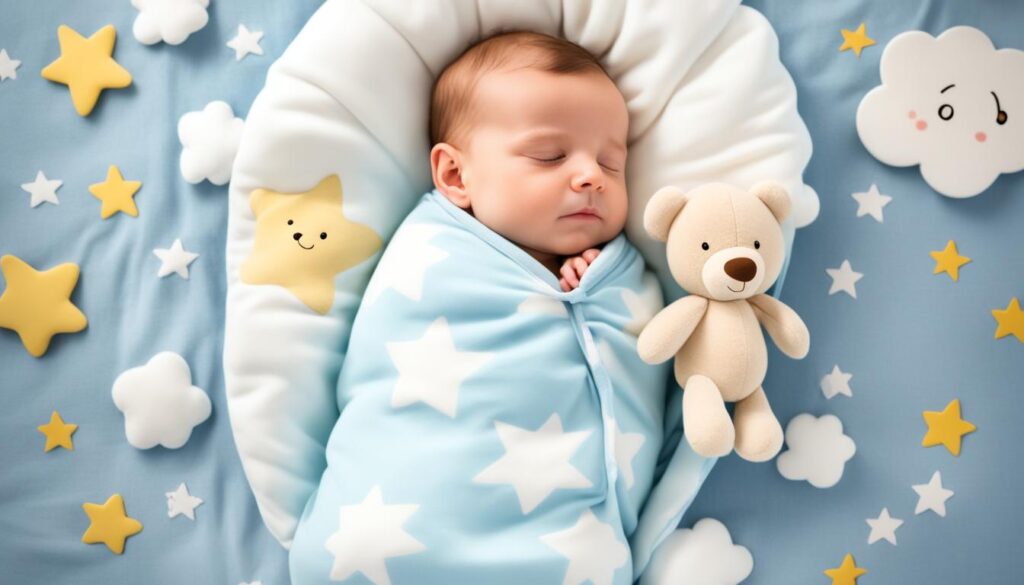
“The key to safe infant sleep is minimizing any potential hazards, and sleep sacks are an excellent way to achieve this.”
Pediatric Sleep Tips and Recommendations
As your little one grows, it’s important to know when to introduce a blanket and follow safe swaddling practices. These tips can help ensure your baby sleeps well and safely.
Transitioning to Blanket Use
The American Academy of Pediatrics says not to use loose bedding, like blankets, for babies under 12 months. This is to lower the risk of sudden infant death syndrome (SIDS) and suffocation. When your baby turns 12 months, you can start using a lightweight, breathable blanket. Make sure it doesn’t cover their head or face.
Age and Developmental Milestones
At 4-6 months, babies often learn to roll over and grab things. This might mean it’s time to switch from swaddling to a sleep sack or a light blanket. By 12 months, babies can take off a blanket if they don’t like it. This makes it safe to use blankets in their sleep routine.
Safe Swaddling Practices
If you swaddle your newborn, make sure it’s tight but leaves room for hip movement. Don’t let the blanket cover the baby’s face. Stop swaddling when your baby tries to roll over to avoid risks like entrapment and trouble breathing. Always put a swaddled baby on their back to sleep.
FAQ
When is it safe for my baby to sleep with a blanket?
The American Academy of Pediatrics (AAP) says wait until your baby is at least 12 months old before using a blanket for sleep. Blankets can be a big risk of suffocation and SIDS for babies under 1 year. Use sleep sacks or swaddles until they are 12 months old for safety.
What are the risks of loose bedding for infants?
Loose bedding, like blankets, is a big risk for babies. It can cover their face and block their air, leading to suffocation. It can also wrap around their neck, causing strangulation. This is very dangerous for babies under 1 year, so the AAP advises against it.
How can I create a safe sleep environment for my baby?
For a safe sleep area, pick a breathable crib mattress and use fitted sheets. Don’t use pillows, loose blankets, or bumper pads because they can be a suffocation risk. Use a sleep sack or swaddle to keep your baby warm safely. The nursery should be cool, dark, and quiet for good sleep.
What are the differences between sleep sacks and blankets?
Sleep sacks are safer than blankets for babies. They keep your baby snug and safe from suffocation or strangulation risks. They also help keep your baby at the right temperature. Blankets can cover your baby’s face and get tangled around their neck. For the first year, sleep sacks are the safer and more comfortable choice.
When can I start using a blanket for my baby’s sleep?
Wait until your baby is 12 months old before using a blanket for sleep, says the AAP. When you start using a blanket, make it lightweight and breathable. Tuck it in at the crib’s foot to prevent suffocation. Always watch how your baby reacts and adjust as needed for a safe sleep.
How can I safely swaddle my baby?
Swaddling safely is key for your baby’s sleep. Use a light, breathable fabric and make sure the swaddle is snug but not too tight. Your baby’s hips and knees should be free to move. Stop swaddling when your baby starts trying to roll over, usually by 2-4 months.

